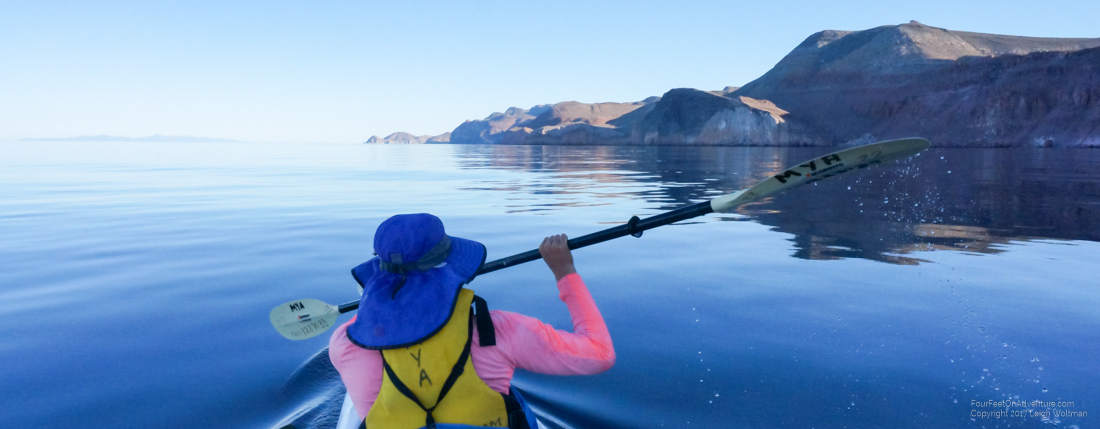
Around La Paz
What a busy week it has been! We finally got into La Paz at a decent hour and started exploring around this town. We first visited a restaurant so simply called Taco Fish La Paz, which was recommended in the Lonely Planet guide. The fish tacos were cheap and pretty good. You got to dress your own with toppings so there would have been quite a few options to try. They had a really interesting selection of sauces, probably over 100 different bottles on a rack. Unfortunately, most of them probably would have been killer hot for us so we skipped that offering.
We then found a rental outfit for kayaks and decided to go on a kayak adventure. We have all the camping gear with us and because we have outfitted the BOB trailer with dry bags most of our gear is ready for the water. We debated upon getting single kayaks but they didn't look that great, and a tandem saved us some cash so we opted to pedal from a tandem bike to a tandem boat. The boat would include paddles and life jackets. We wanted to head to a protected island group off the coast of La Paz which is part of a UNESCO biosphere reserve. We had to pay for park passes and also rent a little porta-potty to pack out all waste.
The islands are about 10 km offshore. We first planned to pay for a vehicle shuttle out to the tip of land closest to the island as it was cheaper but we then found they had to pick another group up on the island the same day we were starting. We then negotiated a good deal on taking a boat shuttle out. The kayak company was part of a hotel, so they had space to store our bike and extra gear in locked rooms. So, it was all set that we would leave the next day, so we headed to pick up some groceries and back to sort our biking gear into kayaking gear. On the way back to our campground we stopped at a Little Caesars pizza and split a pizza.
The next morning we arose early and had to finish packing. With all the gear we needed for kayaking packed in dry bags and all the biking stuff in other bags, along with groceries for four days nothing really fits on the bike. We had bags hanging from every handle bar for the 10 km slog into town.
Once at the kayak rental outfit we sorted our gear and stowed the rest. We then threw all our gear into a boat sitting on a trailer and the crew loaded the kayak on top of the boat's sun roof. We walked a block down to the water and they launched the boat and us into the La Paz harbour. We had about a 25 km boat ride out of the harbour and to the first beach on the island. It only took about 30 minutes, but allowed us to familiarize ourselves with the shore line as we would paddle back to both experience this shore line and save money by not paying for another shuttle.
Once at the beach, the driver helped off load our gear and boat onto the sand and then was off. Leaving us on Isla Espiritu Santo with a decent pile of gear to fit into the boat. Fortunately, a tandem kayak has so much room that it was trivial to pack it up. Even the bulky porta-potty fit in front of Annette's feet. We ate down our cinnamon bun supply and started our paddle. Our rough plan was to circumnavigate the island group. It is two islands which stretch out north-south with a small channel of water separating them. We were navigating from a photocopied map, which means that, even though I said I was a BCU certified sea kayak leader to allow us to take the boat on our own, we weren't really prepared in the best way possible :)
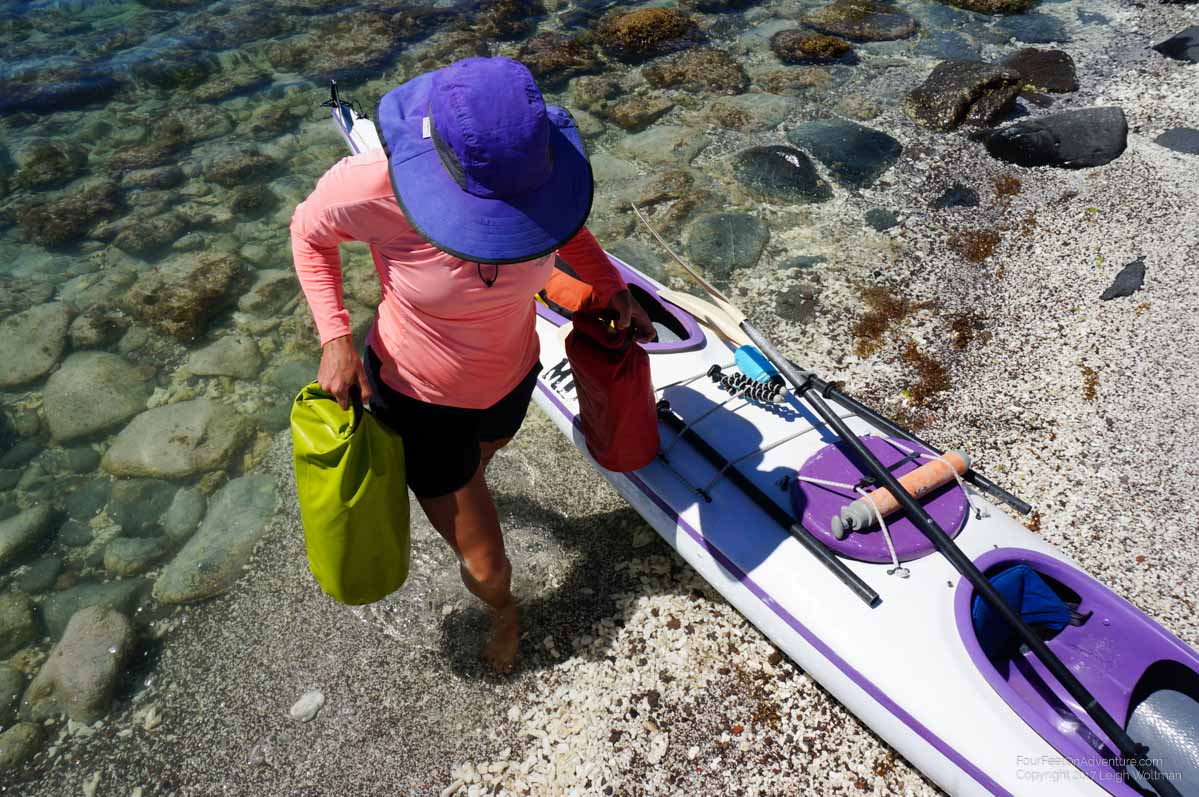
Crossing the first bay, lots of frigates soared overhead. Before completing the bay crossing, Annette spotted a sea turtle who also spotted us and quickly dove back down. Soon, a pod of dolphins chasing fish swam by about 50 metres off our bow. We tried to located them again, but they seemed a little shy. We could see schools of fish below our boat scattering as the dolphins probably gave chase, but we didn't see them again until they were in the distance.
We continued north with only gentle breezes. Schools of baitfish hit the surface as we paddled out to some small islands that were protected. We aren't allowed to land on them but we ventured out to them anyway to see what we would find. The baitfish keep hitting the surface, but we would never know what was spooking them up.

We stopped for lunch on a rocky beach. The entire beach was all coral sand, mixed with big pieces of washed up coral. We sheltered from the midday sun under a small rock undercut. As we paddled on, in the distance Leigh was pretty sure he saw a ray jump out of the water. This was quite exciting, as back in Guerro Negro when we needed a rest day we decided to watch Netflix. A movie turned into an impossibility as Netflix follows your location for movie options, therefore everything popular was in Spanish. We ended up watching a BBC special on sharks. In this, they did a segment on mobula rays of the Baja which peculiarly jump out of the water. We thought it would be cool if we saw this, but the Internet seemed to conclude that this only happens at certain times of the year.
Anyway, to our shock, another ray jumped out of the water, trying to make the biggest belly flop, this time closer to our kayak. What luck we thought. After that the sea was quiet and we moved on.
As we rounded another point, another ray jumped into the air. These animals are really neat, wide flat bodies, some more than a metre in 'wingspan'. They jump straight out of the water and flap their wings or pectoral fins like they are trying to fly. However, they are likely trying to flap down as hard as they can to make the biggest splash sound. Suddenly, several more jumped from the water. We hung out and what we found was a school of rays. When we got to the centre of this school, we could look down into the water and see thousands of rays swimming a circle probably 100 metres in diameter. They were probably about 2-3 metres down and gently flying in formation with each other. Then, about every minute or so, several from the outside of the formation would leap into the air, trying to make this belly flop. They can achieve a height of a couple metres and occasionally also do a backflip which may or may not be intended.
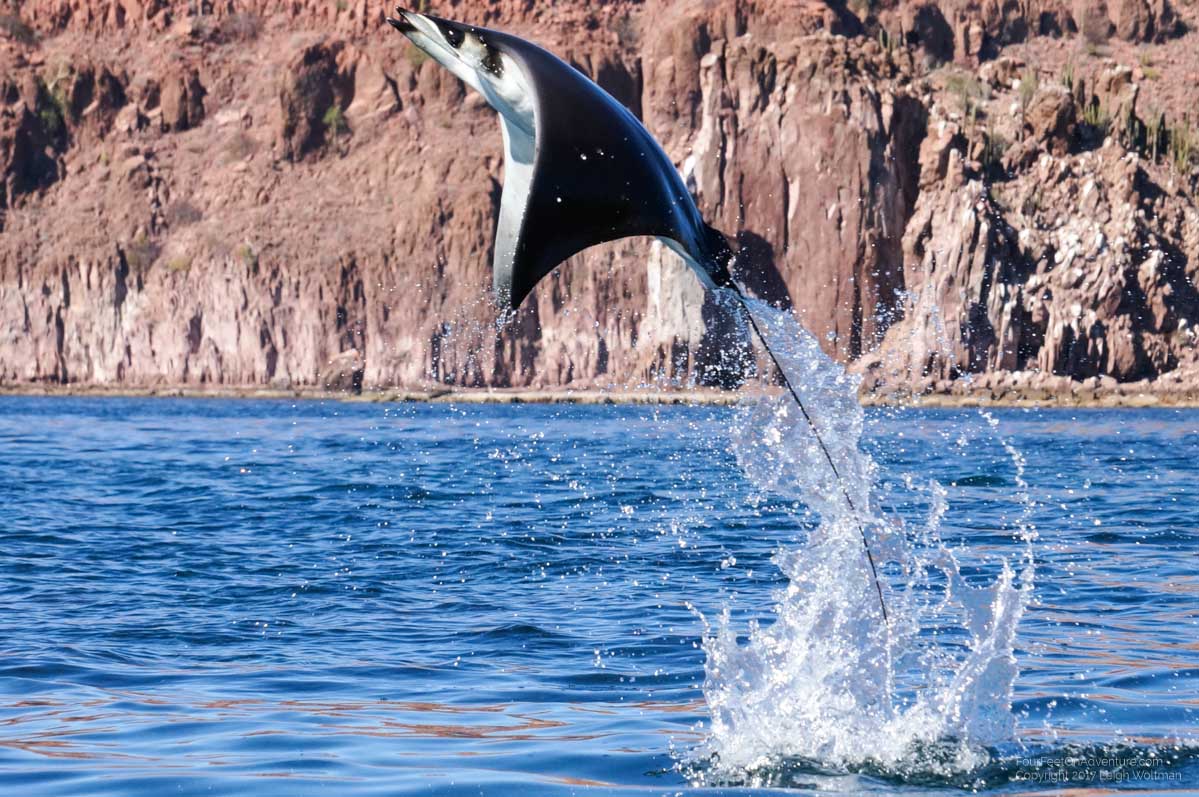
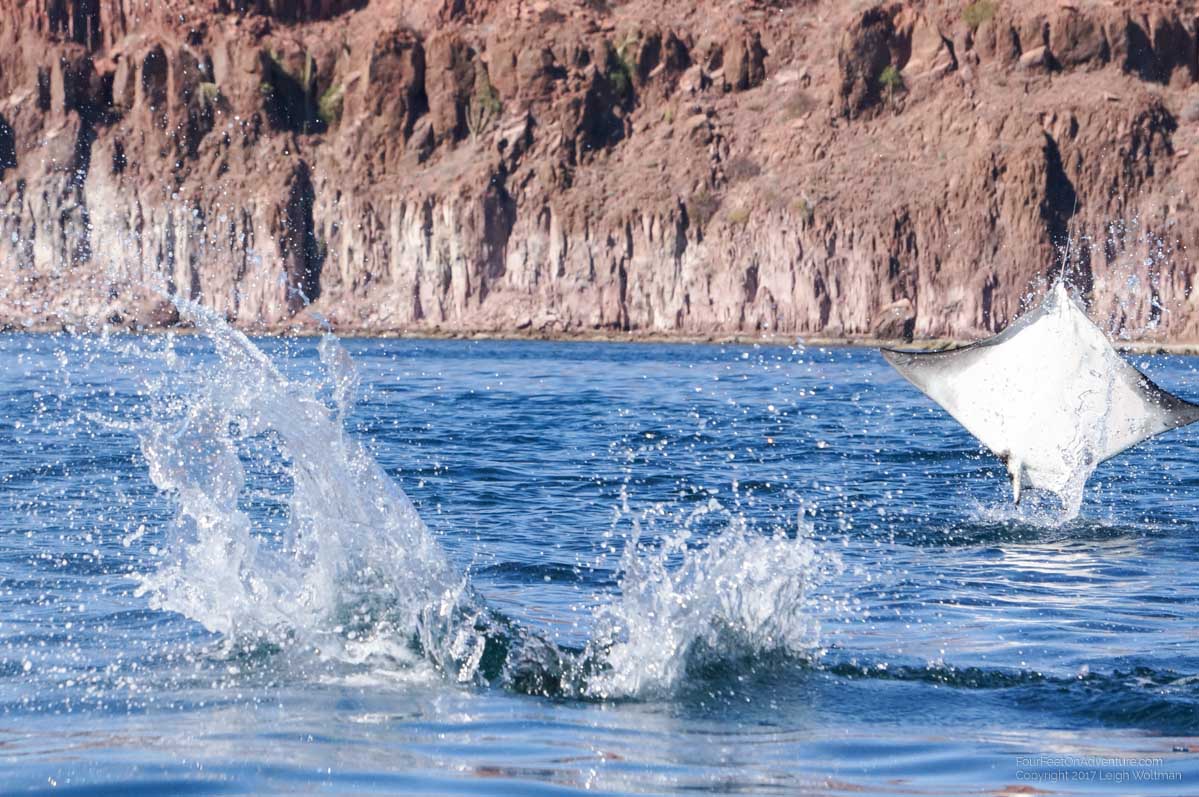
This school was so big that we could see the centre of their schooling circle as they were creating a slight whirlpool at the surface of the water and bubbles were collecting in the middle marking the centre. We could easily follow this to keep close. Imagine so many animals swimming in a circle a couple metres down that they were gently spinning the water at the surface.
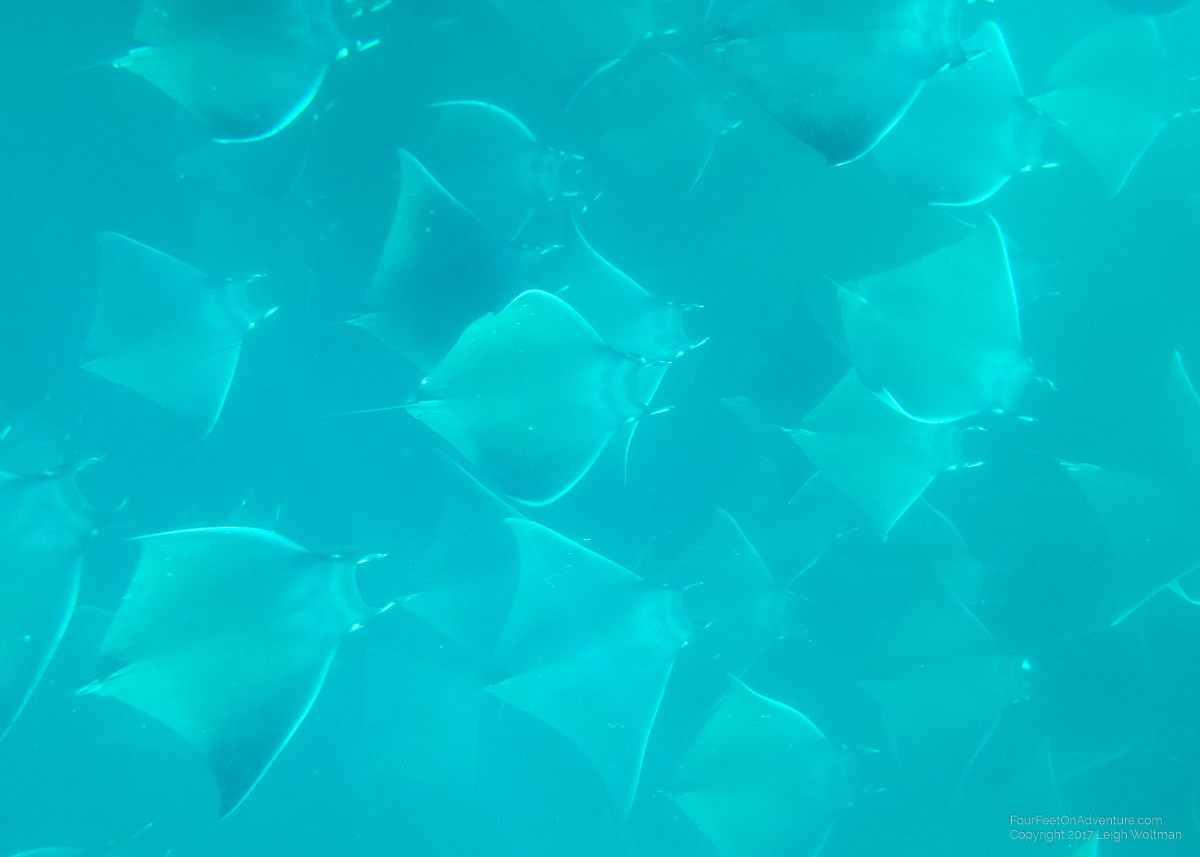
We quickly learned we might not want to be too close. First, one jumped right onto the front of the kayak, knocking the paddle from Annette's hands. Secondly, one jumped right behind me, bouncing off the rear of the kayak in what turned out to be a perfectly timed picture.
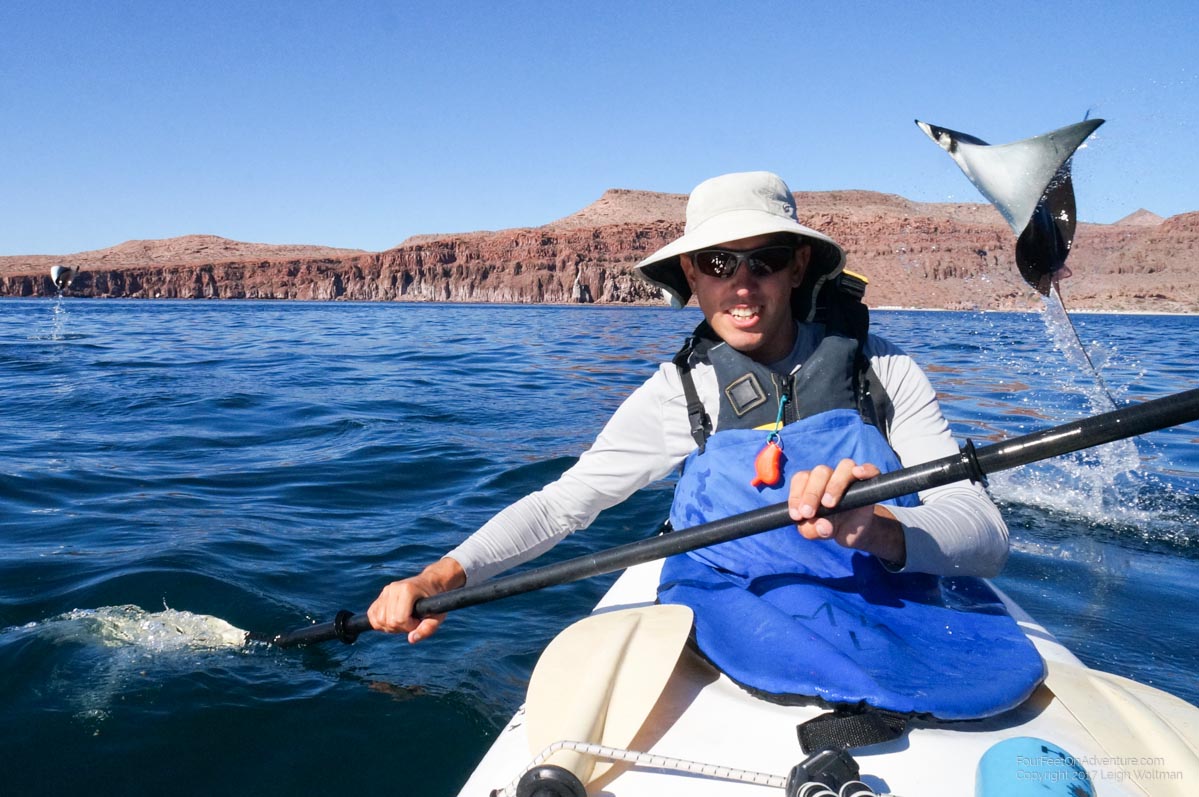
Nobody knows for sure why they do this but it seemed to us that it must be to get attention in the group. Only rays on the outside of the schooling circle seem to jump. We lost ourselves for at least 2 to 3 hours before the sun was starting to head down and we realized we should probably find camp. Leaving this group, we found another, were they were circling closer to the surface raising the tips of their wings from the water marking their presence. However, as soon as the kayak got close they would drop back deeper into the water.
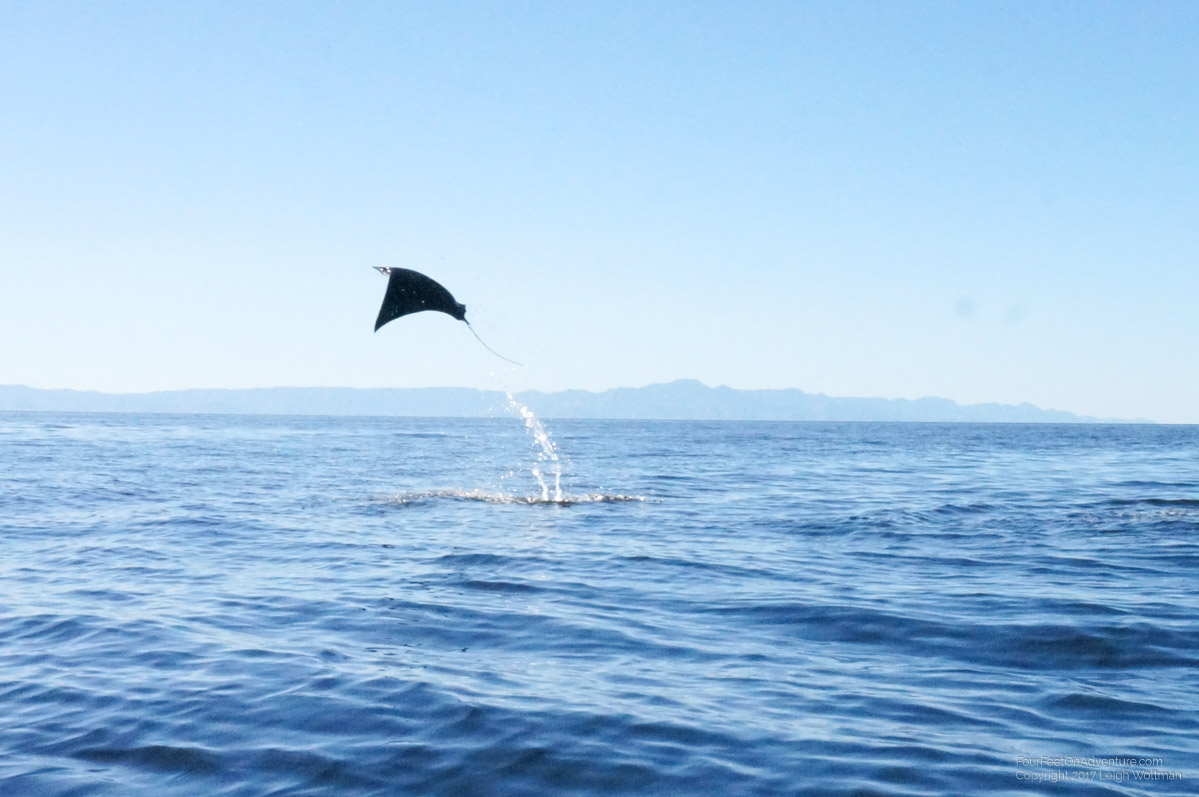
We paddled on towards a beach. Unfortunately, Annette had been starting to feel worse and worse throughout the day, and by the time the tent was up, was pretty much in bed with chills and fever. She was definitely feeling pretty rough with the additional stress of not wanting to be sick on the kayaking trip that was just starting.
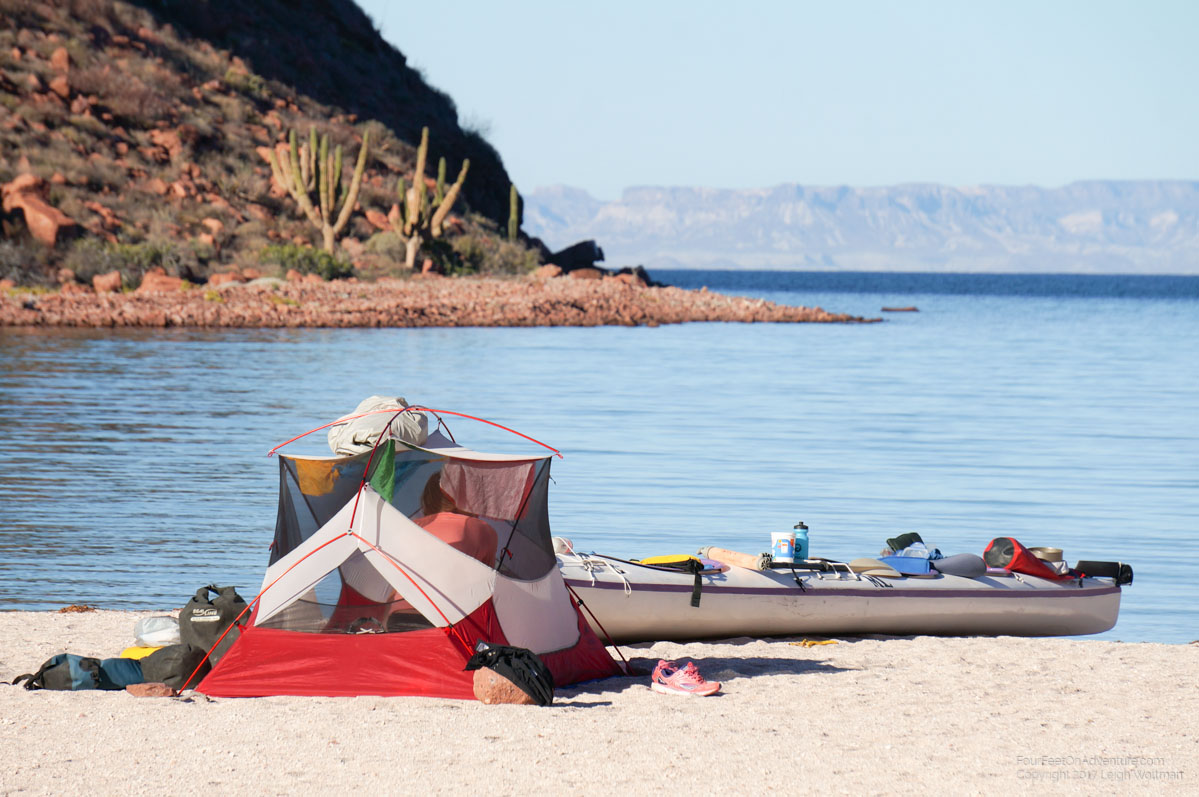
The next morning, was slowly rounded up camp from our beach. We were told there would be lots of activity on the island but we still has this beach and cove all to ourselves. With the kayak loaded, Annette got some energy back and we paddled north. There's a sea lion rookery on one of the small rocks off the north end of the island group that we wanted to see. Along the way, we passed some more coves with moored sailboats that had spent the night. Eventually, we found a small rocky island with some sea lions. One of the tourist attractions is to snorkel with them and at this one a woman was swimming around the islands the some of the younger sea lions did come and swim around her. They didn't seem to interested in us however which was a little disappointing. The bull male on the island was clearly bigger than the others and as we neared definitely made his presence known.
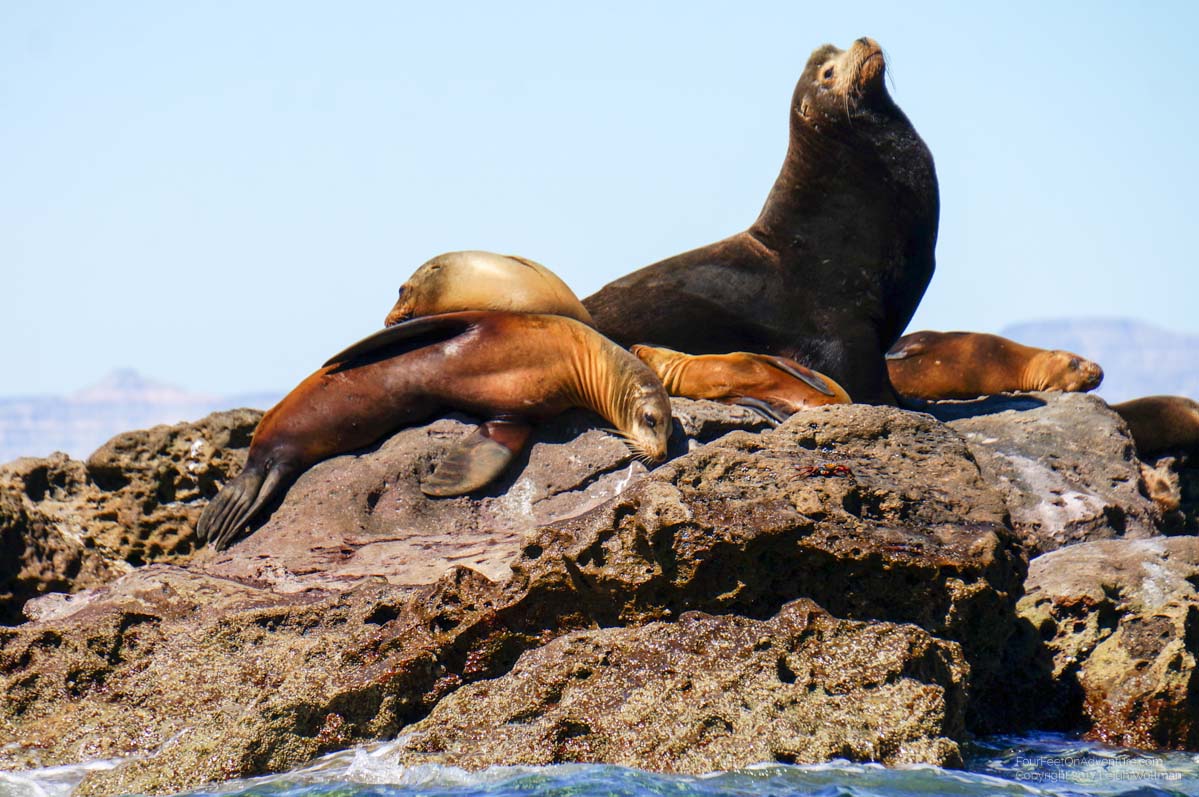
We watched the sea lions for a little bit, and then decided to find a cove for lunch. The rocky shoreline here gave us a couple sea arches we could easily paddle through. Heading towards the most northerly beach we made a rocky landing instead since there was no swell. Here, after lunch we could snorkel with good visibility and saw all kinds of fish. The water was a little cool but once in, it was quite nice.
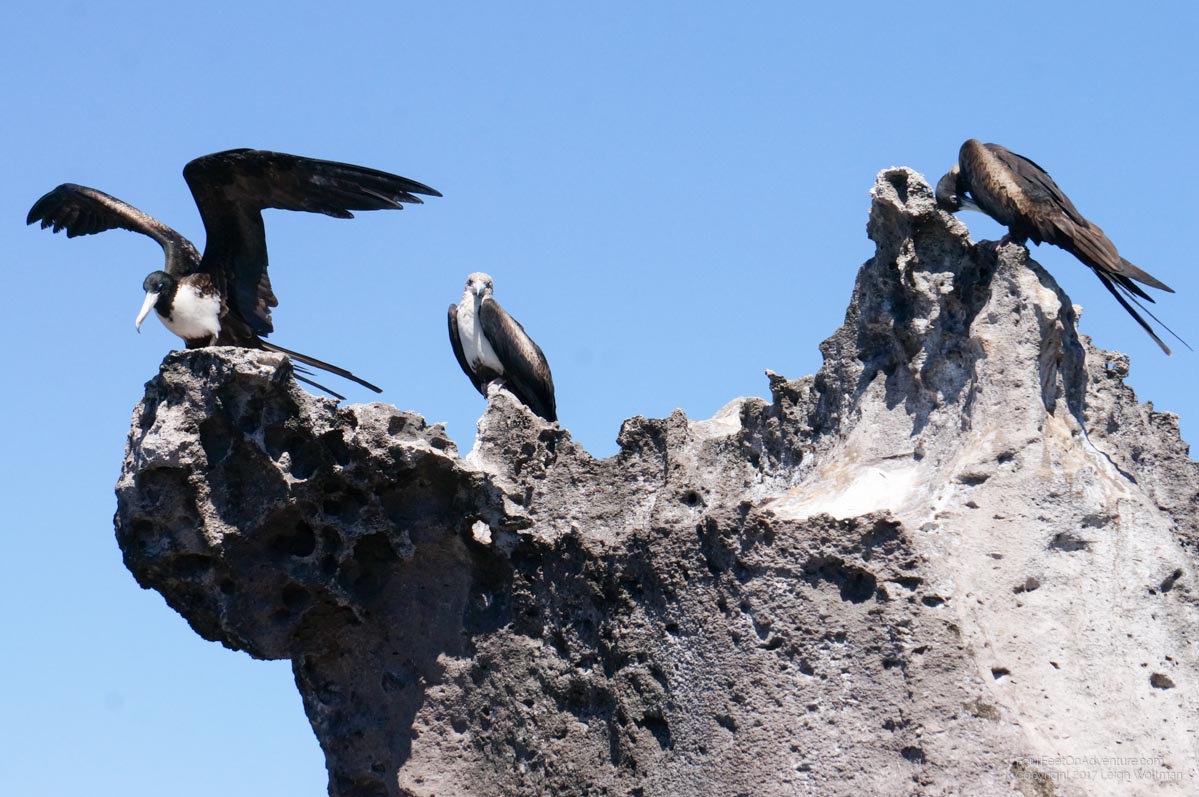
Heading towards the sea lion rookery, we saw something eating some floating seaweed. However, as soon as the kayak would get close, whatever what under the water, would disappear with a small splash at the surface. We never did see what this was.
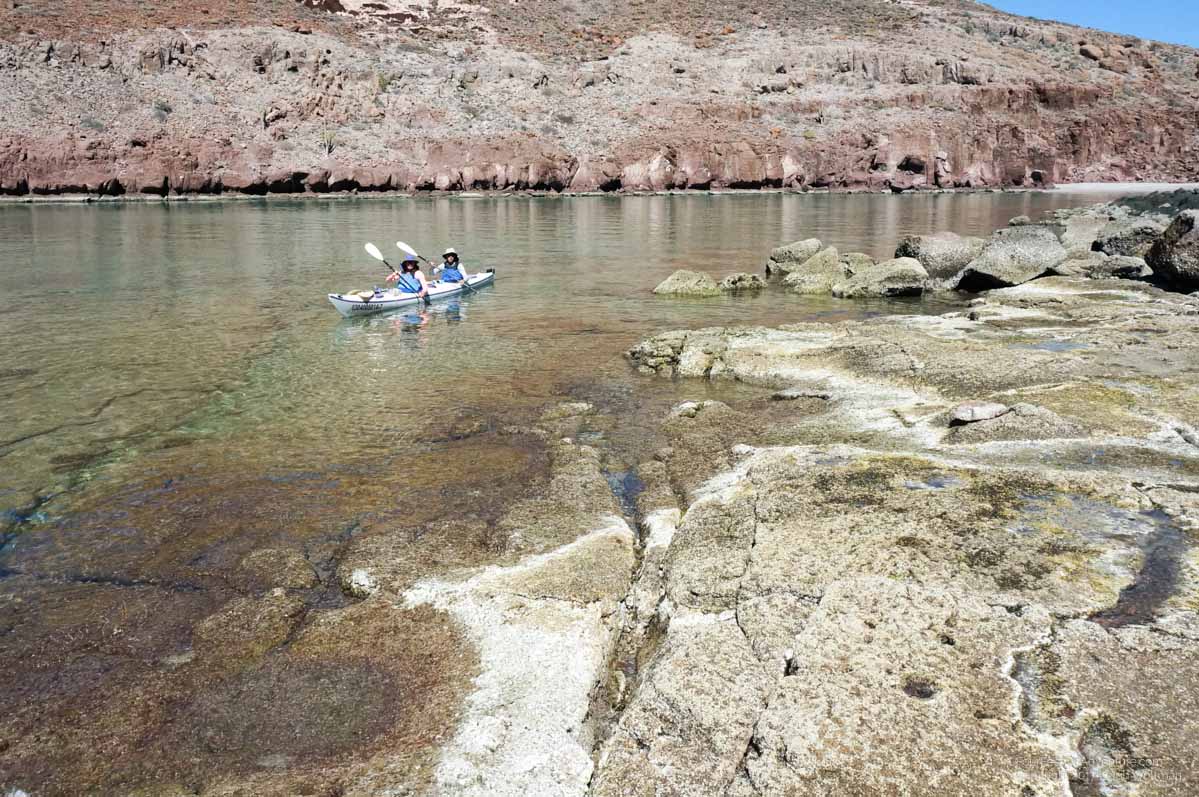
The sea lion rookery had of course lots of sea lions. Fortunately, we arrived later in the day and many of the tour boats has left or were leaving. This allowed us to have a nice peaceful float around the island. Here, some of the young sea lions were interested in us and came out to visit the kayak. They never got too close but were definitely playful in their disposition. They would often swim underneath the kayak, and we could see their dark bodies quickly slip through the water below.
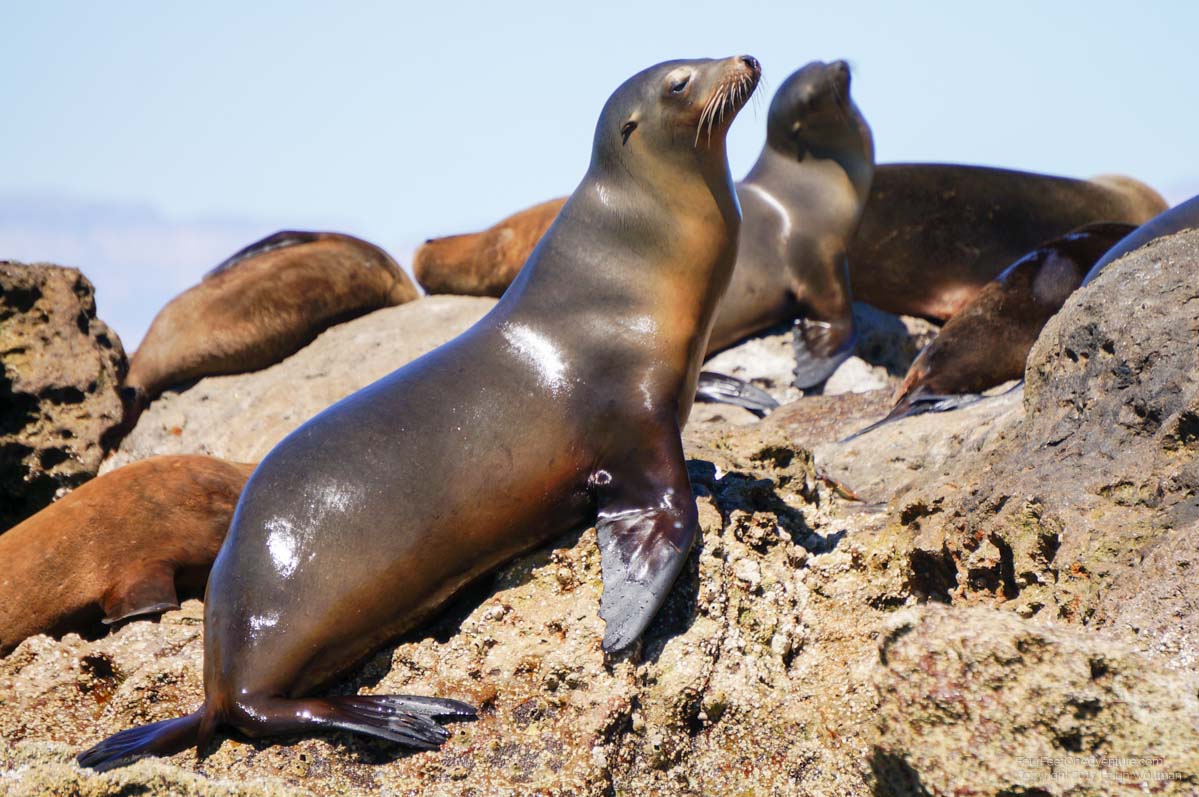
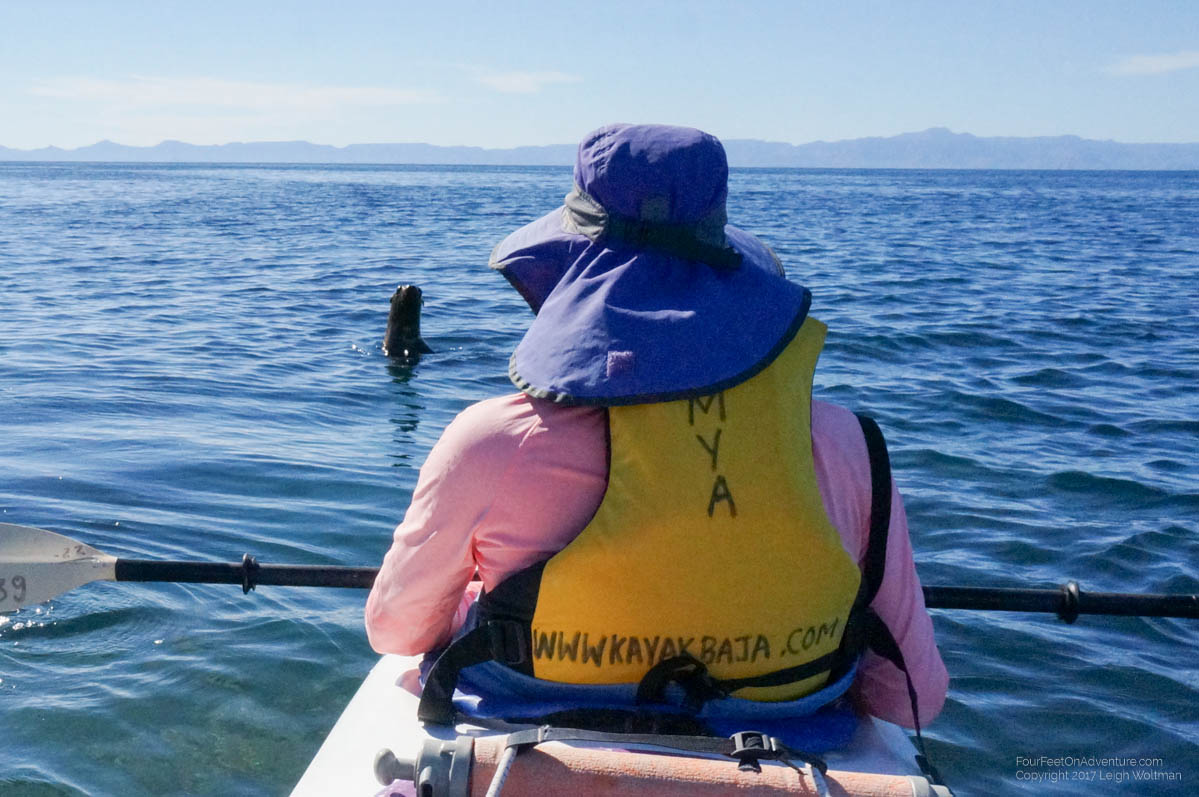
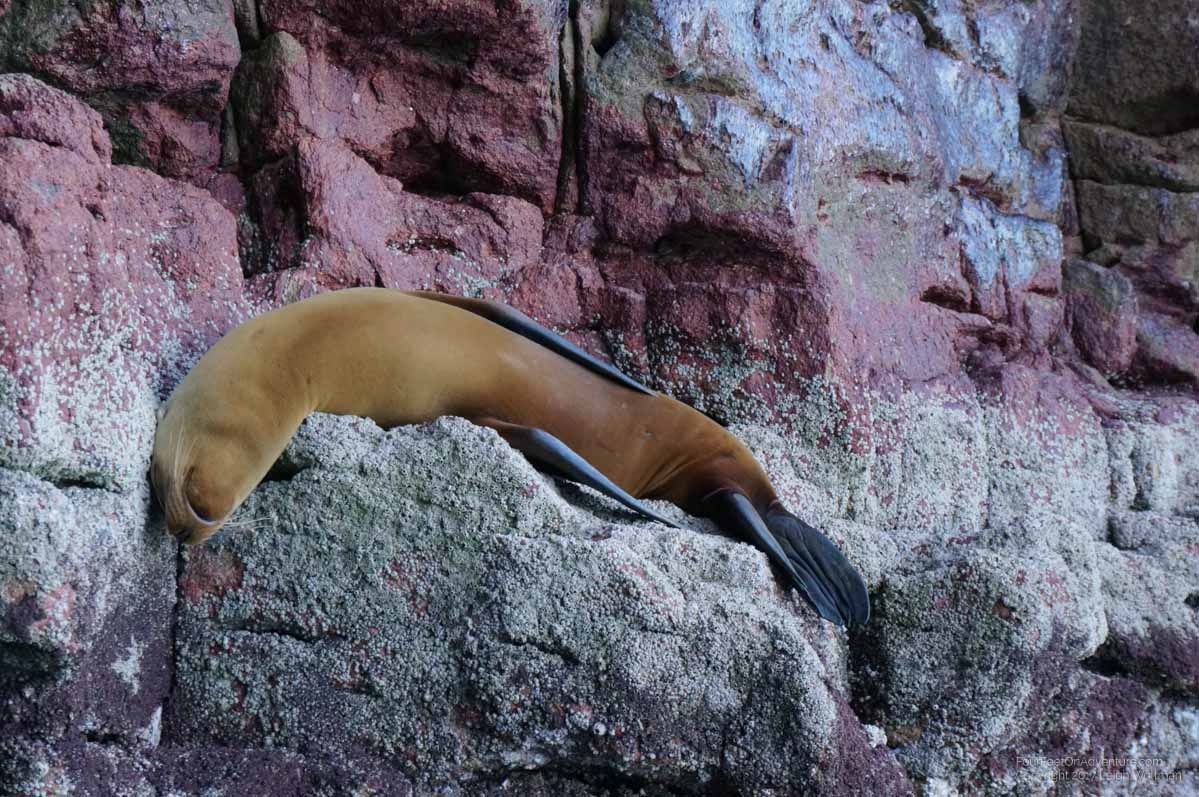
Again, a setting sun meant we had to move on. We circled around the north end of the island group, hoping to make some distance in our circumnavigation so that the next day wouldn't be too long. The east coast of the island is rocky and the wind dropped as we paddled our last leg of the day giving beautiful calm conditions. Occasional jumping rays caused us to stop and delay more often than ideal.
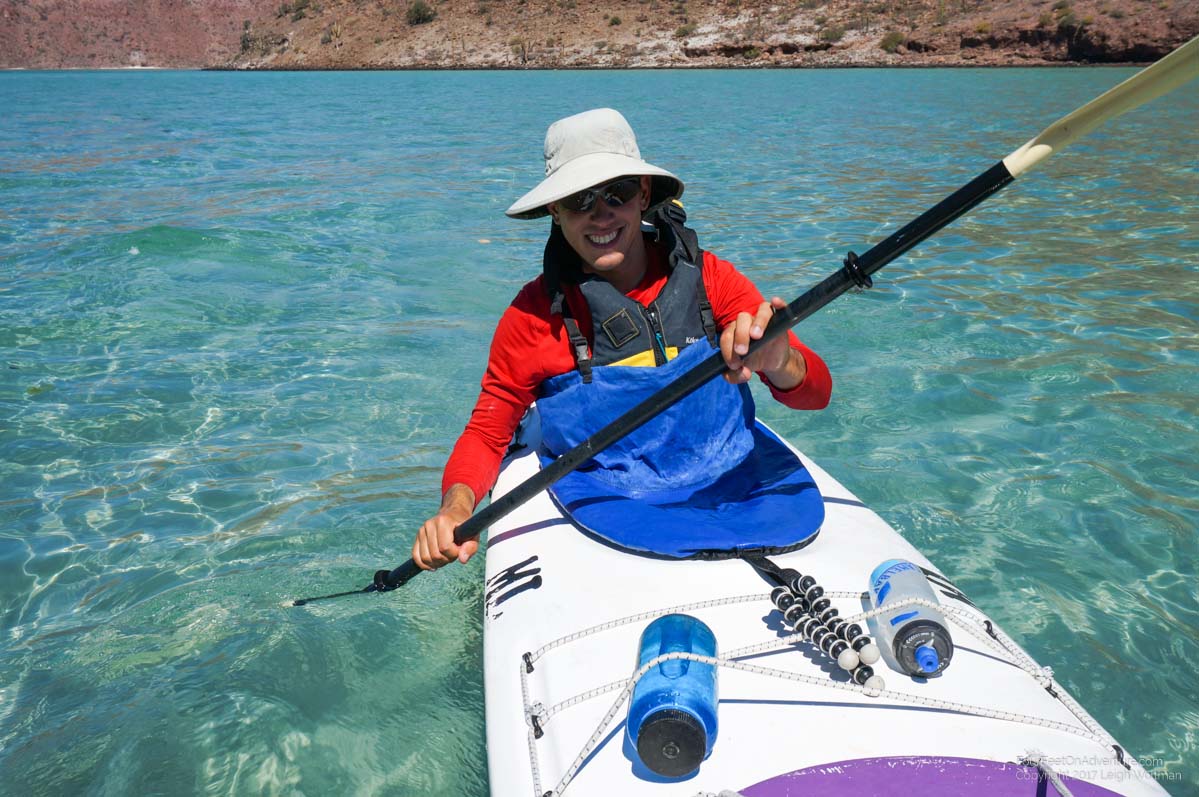
We cut through the channel separating the two main islands where fishermen have some fish camps. They were filleting the day's catch so we aimed for another beach and the end of a shallow bay to sleep for the night. The beach was so shallow we had to wade ashore. We slept late the next morning, kicked from the tent when the sun hit it, making it intolerably warm.
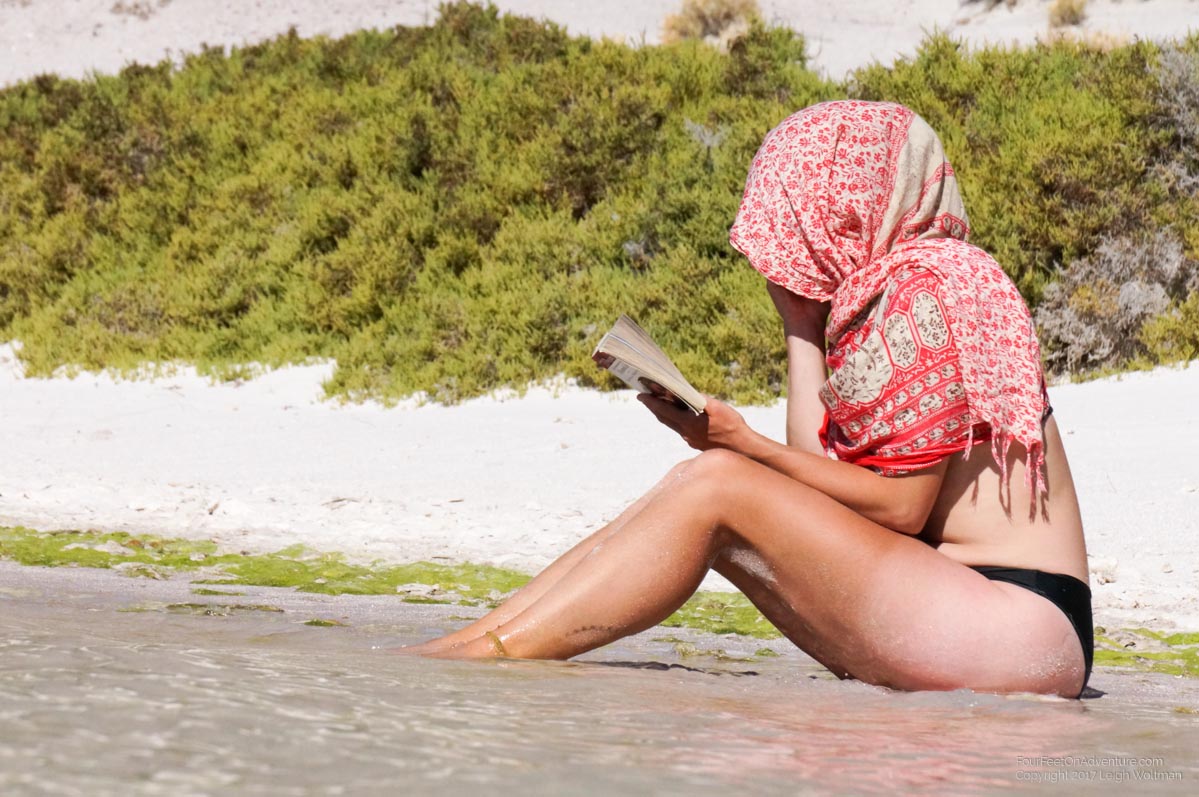
We continued our circumnavigation, stopping after only a couple minutes of paddling so Annette could hop into the water and snorkel for a bit. Leigh thought he had just as good of a view looking down from the kayak. The wind wasn't up yet so the surface was pretty smooth. Further along the coast we found large sea caves. Most had multiple entrances and were easily five boat lengths deep. The cliffs continuing on this east side of the island group are large, evidence of the size needed to stand up to the entire width of the Gulf of California.
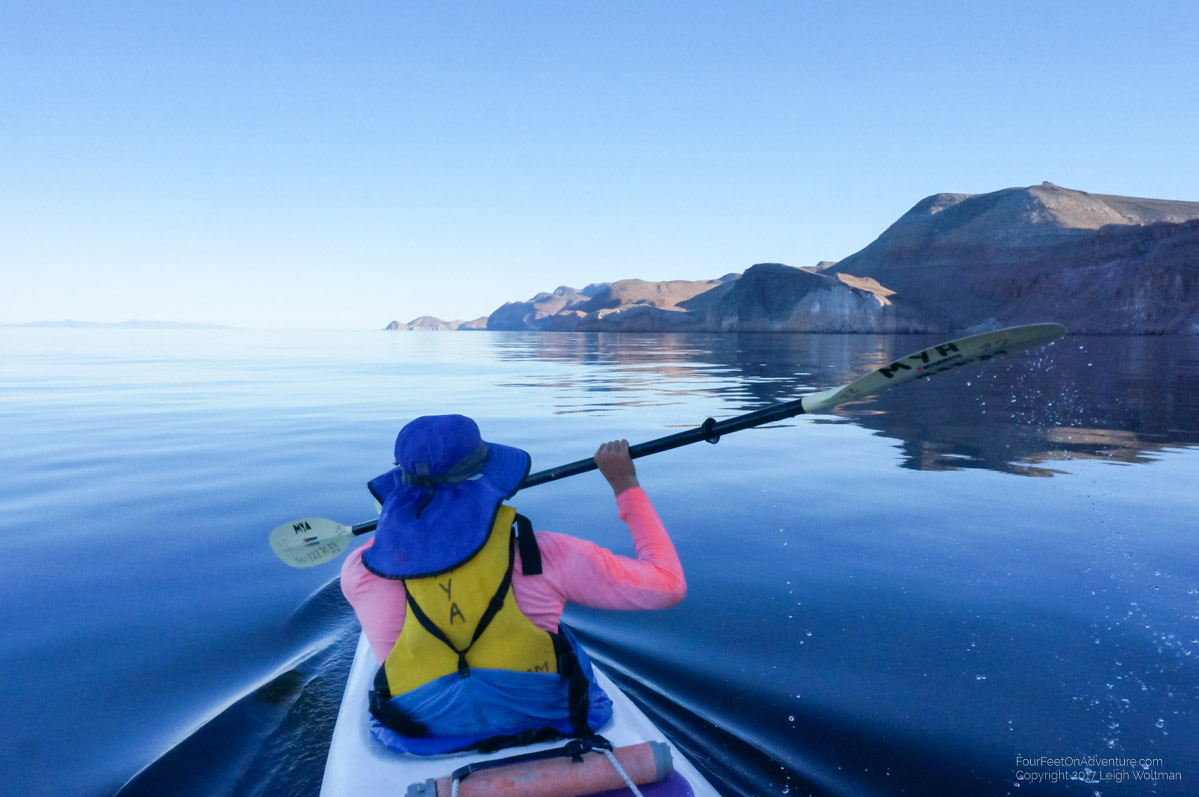
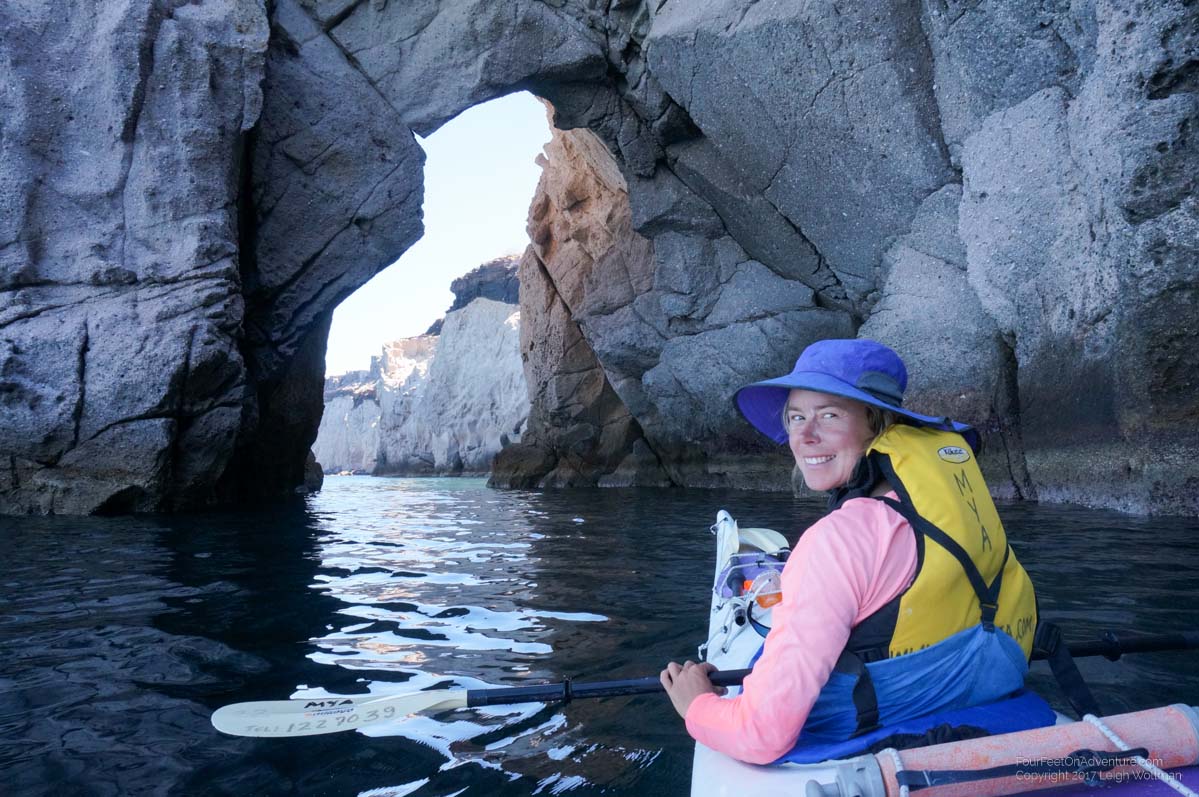
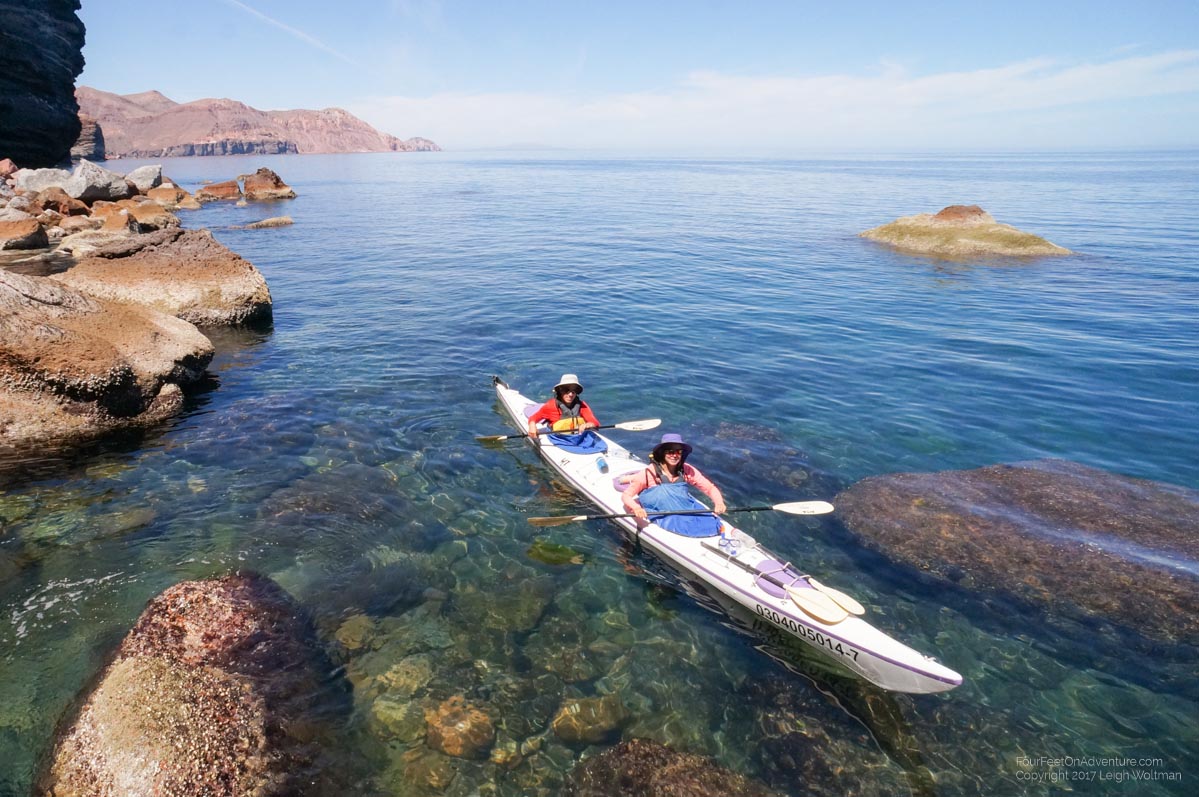
After a stop for lunch on a shore full of palm sized crabs we noticed a sea lion surface in the distance. There was quite a commotion and all of a sudden he heaved a fish with a snap of his head. The fish skipped across the surface of the water for several metres. Quickly, gulls and frigates swooped in hoping to benefit from this display. The sea lion threw the same fish or a different fish three more times before moving on. We aren't sure what the intention was, but it was an entertaining display.
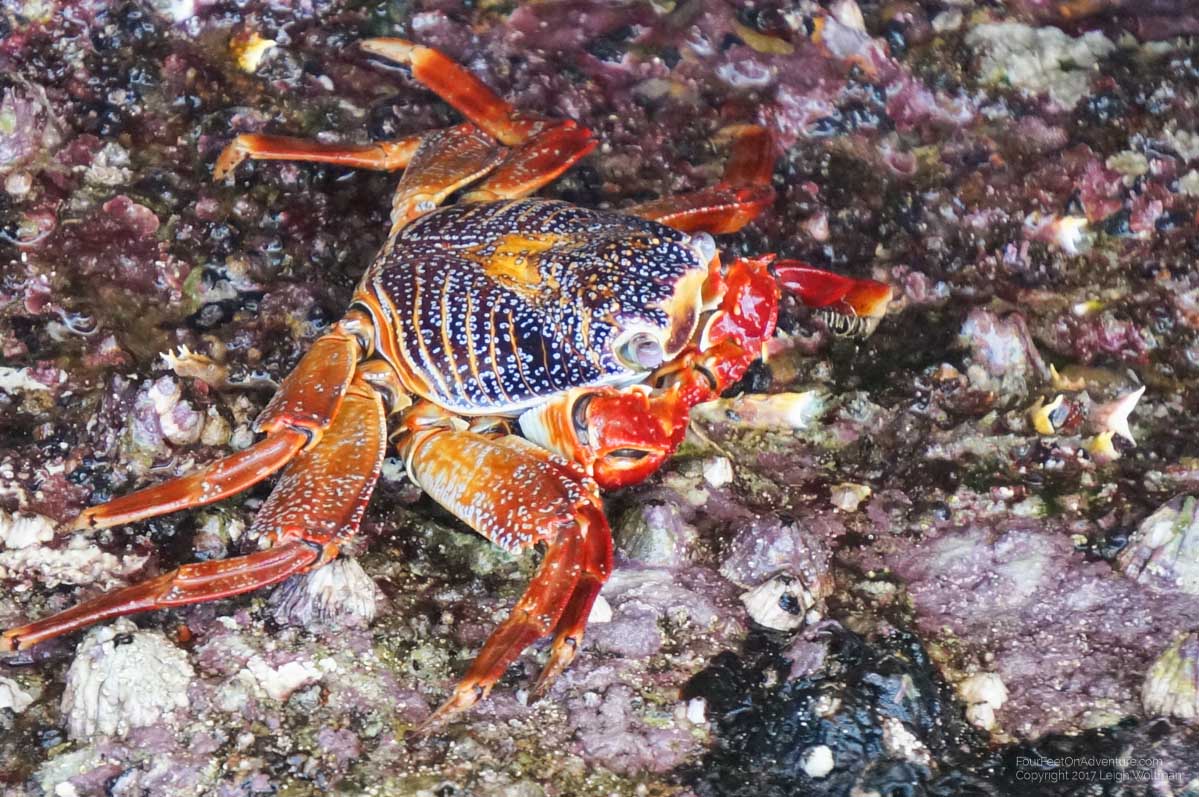
Finally, towards the late afternoon, we reached the southern tip of the island and set up our crossing towards the mainland peninsula. We intended to camp on the mainland so we could save a park pass for one night and also cut down on the distance we have to paddle back the next day. The crossing takes about an hour and half, interrupted by jumping rays and the occasional sea turtle. One didn't seem to notice us, and gently floated on the surface. Eventually, he realized what he had missed and dived out of sight.
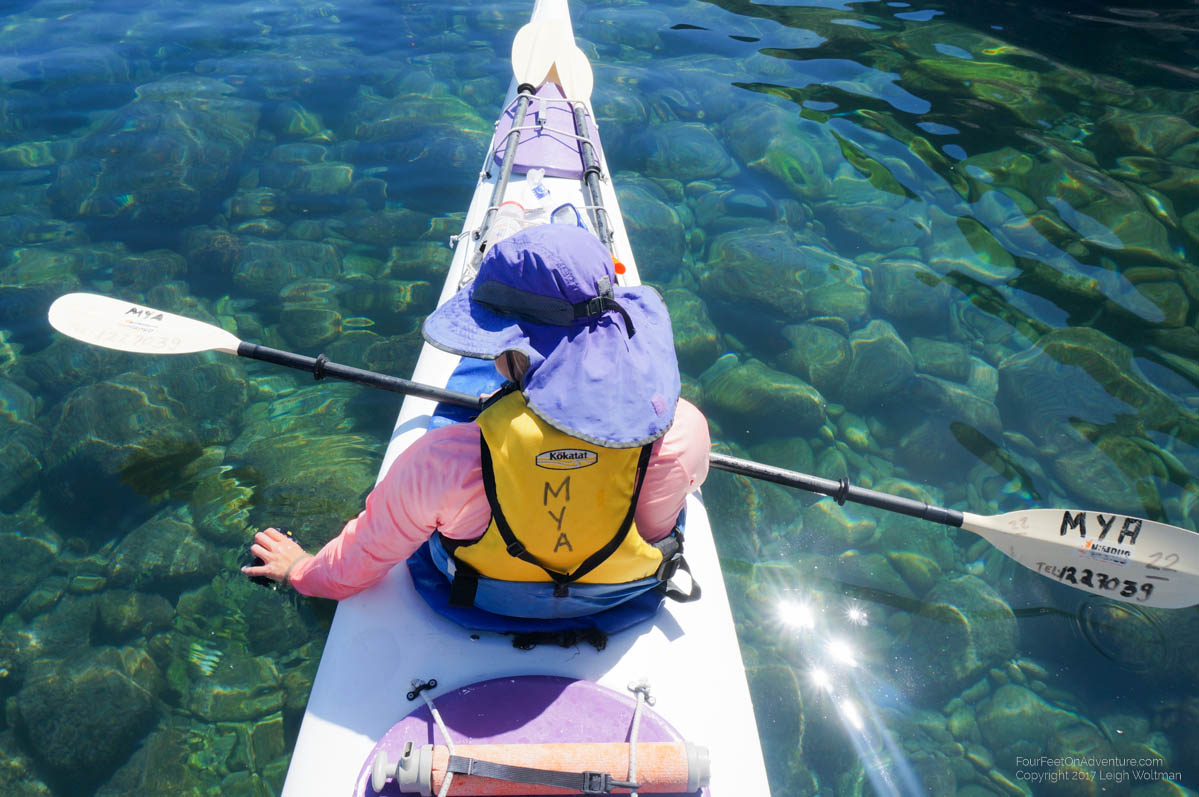
We planned to camp on a beach which is an established RV campground, but as we approached, it was noisy and crowded so we chose one beach over. This beach was deserted except of a hiker from Alaska in his tent, so made for a nice quiet evening watching the setting sun. This beach might have been part of a nature reserve so camping may have been prohibited, but we aren't damaging anything and nobody is around to care.
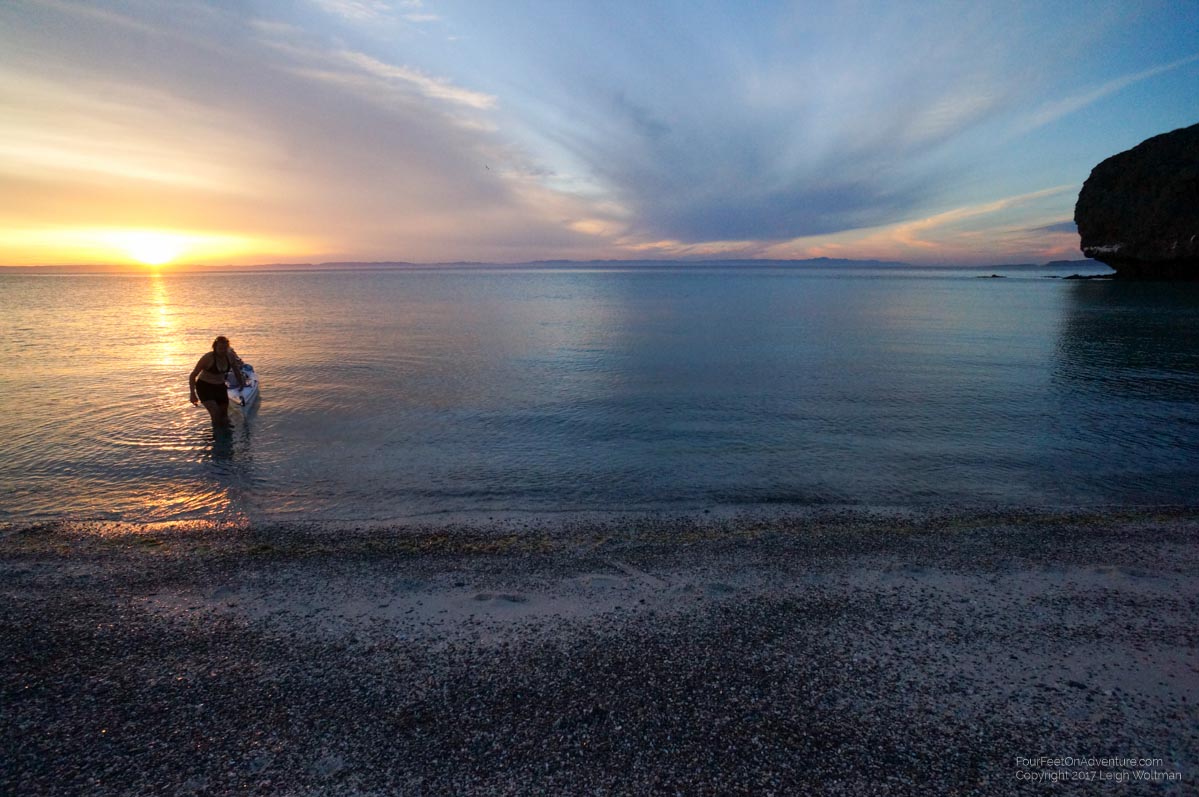
The next morning, we paddle towards La Paz. We made one stop in the first bay which is a protected beach area and said to be the nicest beach near La Paz. Onward, we start getting into populated area passing fish farms and ferry docks. One final pile of rocks hosts a small sea lion colony. Here, several seem happy to be lying in the water on their backs, just floating with their flippers up in the air.
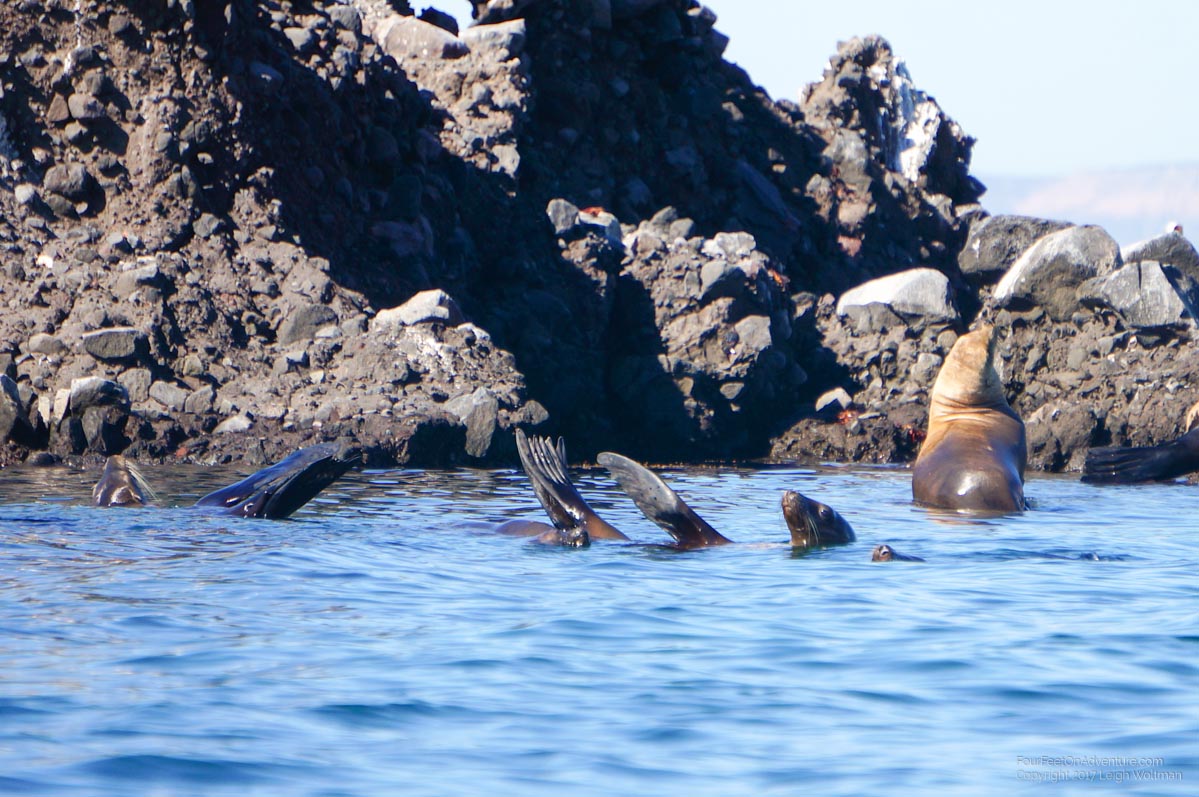
A tail wind is giving a good breeze and we even get some short surfs on the waves coming in. We stir up some schools of flying fish and they take to the air, skipping along the water for several metres in front of us. La Paz is on somewhat of a tidal lagoon which has a large barrier beach, big enough to have resorts built on. The tide which has a range of about a metre here, is flowing out heavily. We have to push against it and set our ferry angle to make progress upstream. We searched the busy harbour front for our agreed upon landing location and make landfall in the early afternoon. I walk to the rental location to alert them to come pick us up with a truck and then wander the couple blocks back.
Once back, we realize the phone has switched time, oh, it is daylight savings time! We think that it is good we came back early otherwise we might have been late returning our rental. Now, we considered saying in downtown La Paz, but we had such a nice, cheap location in the campground that we decide to ride the 10 kilometers back to the campground and hope for the same deal. Fortunately, the owner was happy to see us and gave us the bunkhouse back for our incredible $15 a day deal.
With the time change, we are excited to head to bed early as we are pretty tired. The next morning, we head back into town after doing some cleaning up. We head to a bagel place listed in the Lonely Planet and find it delightful. Fresh bagels with lots of nice cream cheese. We also hunt around for a place to take a whale shark tour. The whale shark was another Baja fish we saw in our shark Netflix night. It is a shark that has adapted to use its gills to feel on plankton just like a baleen whale (hence the name) and it doesn't have any teeth. They frequent the water around Mexico and La Paz is the central spot to go snorkeling with them. The best deal which will include storage of the bike is connected to the whale museum in town so we setup that on Thursday before we catch the ferry we will head out on a snorkeling tour.
On the way back we stopped at Walmart to get dinner and we ran into Pierre, the French cyclist with the surfboard. He has been waiting in La Paz for a replacement tent. Apparently the first one was sent with the Mexican postal service something like six weeks ago and still hasn't arrived, so another one has been sent via FedEx and he is just waiting for that. We tell him all about the time change (keep this in mind) and catch up on stories.
After a rest day, Thursday morning, we are up at 6. I noticed that with the time change, the sun hasn't even started to fade the blackness from the sky. We pack up and head into town, first to get ferry tickets. Standing in line, we notice the clocks in the room all say one hour earlier. With some Googling, we find that indeed, Mexico does not use the same daylight savings as Canada and the US. We adapted ourselves early for no reason. Oh well, we were running behind on the day already so an extra hour will really help, and we will enjoy the extra hour of sleep tonight!
Purchasing the ferry tickets, the girl first tells us that there are no more tickets for the boat today, and then somehow sells them to use anyway. They are sold out of cabins and Leigh doesn’t want to miss a good night sleep on the overnight ferry so he convinces Annette to purchase a 'suite'. He explains that it is still cheaper than all the hotels we used in the US.
Then it was on towards the whale museum where we get a free tour because of our snorkel booking. We spent at least two hours going through the museum filled with whale skeletons, very well done. Then we had a quick lunch again at the bagel place before outfitting yourself for the snorkeling. Here, a guide is assigned and the good news is we have only one other person in our group. We get on a boat in La Paz and the driver of the boat heads out to the barrier beaches. Here, they spot a whale shark swimming in probably 3 metres of water along the sandy bottom. These are just babies, but they are still around 6 metres long. The boat sees where one is swimming and we all jump into the water in front of the shark. It swims by and we spent the next several minutes swimming along side of it, as it gently saunters along. After those several minutes, it is clear that only the shark and Annette have the aerobic capacity to swim at that pace continuously so we load back into the boat and head off to intercept another shark. Though it is a bit strange to swim up with a shark, it is so unreal to swim next to such a large fish and see his muscles move when his tail slowly moves from side to side that we both really enjoyed the experience. We do this five or six times before the hour tour is over and we start the boat ride back.
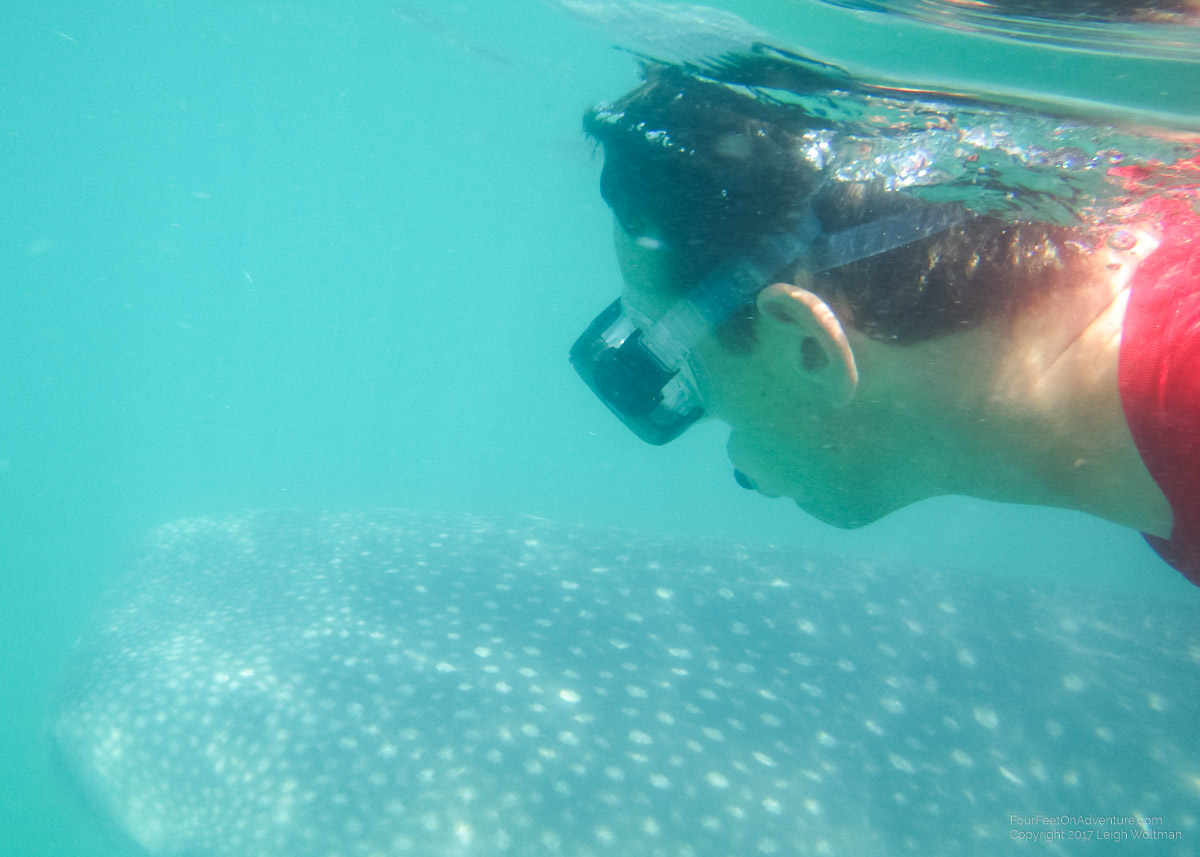
Finally, we must say goodbye to La Paz and we start the 17 kilometer ride out to the ferry terminal. We've ridden 150 kilometers around La Paz, considering every trip between the campground and town added another 20.
We have a pleasant ride before arriving at the terminal. A man directing traffic shows us to take our bike into the passenger terminal. Here, a line extends like an airport of at least a hundred people queued up. He points that we will get let through the line and not have to try weaving our bike through the security lines. After waiting for a couple minutes, the security agent parts the line and we are let through in front of everyone else. Here, we have seen what is going on. You push a button, if the traffic light turns red, your bags are searched, green and you are free to go. Annette walked up to the button, I'm really hoping for green as we have so many bags all perfectly packed. Green it is, and we go on through more doors wheeling our oversized train of a bike. Next up, is a military checkpoint, where they have an x-ray scanner for bags and a metal detector for people just like airport security. The operator looks at us and laughs before he gets permission from his commander to just let us around the whole setup. We found this at the border, if you look like just too much work, they will just let you through!
We wheel up onto the ferry with a break in the trucks and set about securing the bike and trailer to a side wall. We carry all the bags up to our suite, which is by far the best hotel room we've had in Mexico. We have an outside view, a full bathroom including shower, a sleeping room with 4 bunks and a separate TV room with a couch. The only downside is that we find out that what we thought was a 17 hour ferry ride is actually only 12 hours on this new boat, so we basically head to bed and wake up with just enough time to pack and disembark our nice room. I was actually looking forward to the extra time of forced relaxation!
